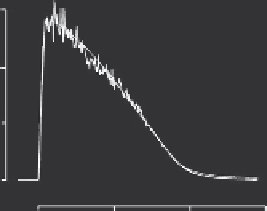Biology Reference
In-Depth Information
2.5
Indo-1
Indo-1
15
Ca electrode
2
10
1.5
Ca electrode
1
5
0.5
0
0
0
250
500
Time (s)
750
1000
0
50
100
150
Time (s)
Fig. 4
E
V
ect of inhomogeneities in [Ca
2
þ
]onaCa
2
þ
-selective minielectrode and indo-1 response in
permeabilized rabbit ventricular myocytes. Panel A shows simultaneous measurements of Ca
2
þ
uptake
in digitonin-permeabilized myocytes with both a Ca
2
þ
-selective minielectrode and indo-1. Ca
2
þ
uptake
in mitochondria was inhibited with ruthenium red. Ca
2
þ
was added at time
¼
0 and was largely
accumulated by the SR. Under these conditions, the response of the Ca
2
þ
electrode was slower than
indo-1. Panel B shows Ca
2
þ
uptake by precipitating intra-SR Ca
2
þ
and thereby preventing buildup of a
[Ca
2
þ
] gradient. Notice that Ca
2
þ
uptake is much faster in the presence of oxalate with no apparent
di
erence between electrode and indo-1 response (from
Hove-Madsen and Bers (1993a)
with
permission).
V
3. Storage of Minielectrodes
After PE tubes have been dipped in an ETH 129 membrane solution and allowed
to dry overnight, the dry electrodes can be stored in a closed glass vial for long
periods. We have filled minielectrodes that had been stored for 3 years and the
electrodes made with PE tubing still had a resistance of 1-2 M
O
with a linear
response down to less than 10 nM Ca
2
þ
after filling. Electrodes made with PVC
tubing had higher resistance (
50 M
O
) but were also functional, although slower
and less sensitive. Storage of the electrodes in plastic vials results in ''Ca
2
þ
-selective
plastic containers,'' as the ETH 129 slowly di
V
uses into the container. Once the
Ca
2
þ
electrodes are filled with the filling solution, however, the response time
increases and the electrodes gradually lose sensitivity.
B. Application of Minielectrodes
Minielectrodes can be used for a number of purposes. The most straightforward
application is the preparation of solutions where Ca
2
þ
is bu
ered with chelators
such as EGTA, EDTA, or BAPTA as described by
Bers (1982)
. We have developed
a spreadsheet that allows calculation of the actual pCa of these solutions, based on
the Nernstian response of the minielectrodes (see Chapter 1). Furthermore, the
spreadsheet allows determinations of the K
d
and the purity of the Ca
2
þ
chelator
used to prepare the solution. Thus we have used the minielectrodes to determine
V










